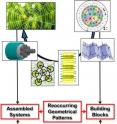Researchers link patterns seen in spider silk, melodies
Using a new mathematical methodology, researchers at MIT have created a scientifically rigorous analogy that shows the similarities between the physical structure of spider silk and the sonic structure of a melody, proving that the structure of each relates to its function in an equivalent way. The step-by-step comparison begins with the primary building blocks of each item -- an amino acid and a sound wave -- and moves up to the level of a beta sheet nanocomposite (the secondary structure of a protein consisting of repeated hierarchical patterns of protein assemblages) and a musical riff (a repeated pattern of notes or chords). The study explains that structural patterns are directly related to the functional properties of lightweight strength in the spider silk and, in the riff, sonic tension that creates an emotional response in the listener.
While the comparison of spider silk and musical composition may appear to be more novelty than breakthrough, the methodology behind it represents a new approach to the comparison of research findings in disparate scientific fields. Such analogies could help engineers develop materials that make use of the repeating patterns of simple building blocks found in many biological materials that, like spider silk, are lightweight yet extremely failure-resistant. The work also suggests that engineers may be able to gain new insights into biological systems through the study of the structure-function relationships found in music and other art forms.
The MIT researchers -- David Spivak, a postdoctoral associate in the Department of Mathematics, Associate Professor Markus Buehler of the Department of Civil and Environmental Engineering (CEE) and CEE graduate student Tristan Giesa -- published their findings in the December issue of BioNanoScience.
They created the analogy using ontology logs, or "ologs," a concept introduced about a year ago by Spivak, who specializes in a branch of mathematics called category theory. Ologs provide an abstract means for categorizing the general properties of a system -- be it a material, mathematical concept or phenomenon -- and showing inherent relationships between function and structure.
To build the ologs, the researchers used information from Buehler's previous studies of the nanostructure of spider silk and other biological materials.
"There is mounting evidence that similar patterns of material features at the nanoscale, such as clusters of hydrogen bonds or hierarchical structures, govern the behavior of materials in the natural environment, yet we couldn't mathematically show the analogy between different materials," Buehler says. "The olog lets us compile information about how materials function in a mathematically rigorous way and identify those patterns that are universal to a very broad class of materials. Its potential for engineering the built environment -- in the design of new materials, structures or infrastructure -- is immense."
"This work is very exciting because it brings forth an approach founded on category theory to bridge music (and potentially other aspects of the fine arts) to a new field of materiomics," says Associate Professor of Biomedical Engineering Joyce Wong of Boston University, a biomaterials scientist and engineer, as well as a musician. "This approach is particularly appropriate for the hierarchical design of proteins, as they show in the silk example. What is particularly exciting is the opportunity to reveal new relationships between seemingly disparate fields with the aim of improving materials engineering and design."
At first glance, an olog may look deceptively simple, much like a corporate organizational chart that shows reporting relationships using directional arrows. But ologs demand scientific rigor to break a system down into its most basic structural building blocks, define the functional properties of the building blocks themselves with respect to one another, show how function emerges through the building blocks' interactions, and do this in a self-consistent manner. With this structure, two or more systems can be formally compared.
"The fact that a spider's thread is robust enough to avoid catastrophic failure even when a defect is present can be explained by the very distinct material makeup of spider silk fibers," Giesa says. "It's exciting to see that music theoreticians observed the same phenomenon in their field, probably without any knowledge of the concept of damage tolerance in materials. Deleting single chords from a harmonic sequence often has only a minor effect on the harmonic quality of the whole sequence."
"The seemingly incredible gap between spider silk and music is no wider than the gap between the two disparate mathematical fields of geometry -- think of triangles and spheres -- and algebra, which uses variables and equations," Spivak says. "Yet category theory's first success -- in the 1940s -- was to express a rigorous mathematical analogy between these two domains and to use it to prove new theorems about complex geometric shapes by importing existing theorems from algebra. It remains to be seen whether our olog will yield such striking results; however, the foundation for such an inquiry is now in place."
The project was funded by the U.S. Air Force Office of Scientific Research, a Department of Defense Presidential Early Career Award for Scientists and Engineers, the U.S. Office of Naval Research, and the German National Academic Foundation.
Source: Massachusetts Institute of Technology, Department of Civil and Environmental Engineering
Other sources
- Researchers link patterns seen in spider silk, melodiesfrom Science BlogFri, 9 Dec 2011, 1:30:16 UTC
- Patterns seen in spider silk and melodies connectedfrom Science DailyThu, 8 Dec 2011, 15:30:28 UTC
- Researchers link patterns seen in spider silk, melodiesfrom PhysorgThu, 8 Dec 2011, 12:01:09 UTC
- Researchers link patterns seen in spider silk, melodiesfrom MIT ResearchThu, 8 Dec 2011, 10:30:35 UTC
